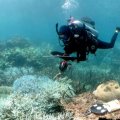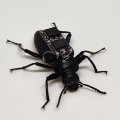UQ supercomputer to position State for future
The University of Queensland will host an immersive virtual reality centre backed by greatly increased supercomputing power and large data storage infrastructure.
The centre will allow scientists to view problems in new ways, by for example allowing 3D walks through molecular structures or virtually viewing pollution flows in Moreton Bay from new angles. It will open up new areas of scientific exploration, provide new insights into complex problems, aid in policy making and enrich the educational process.
The development follows the award of $10 million over three years in the 1999 Queensland Budget to enhance the University's supercomputing capabilities. Strong State support for the venture is expected to leverage future University national and international initiatives.
Supercomputers are high-end, high performance computers, each capable of performing the work of a large number of individual PCs. Currently UQ supports the largest scalable supercomputer in an Australian university, a 64-node Origin 2000 with a capacity of 24.3 Gigaflops.
The State funding will allow the massive virtual reality facility to be enhanced at the University's St Lucia campus. The University will provide it as a major resource to other Queensland universities in the consortium known as the Queensland Parallel Supercomputing Foundation, and to Queensland government agencies. It will be used as a technology amplifier to accelerate research benefits into the community at a faster rate.
UQ's successful bid was submitted by Vice-Chancellor Professor John Hay, Deputy Vice-Chancellor (Research) Professor Paul Greenfield, Director of the University's Advanced Computational Modelling Centre Professor Kevin Burrage and Dr Laurence Lau of that centre.
Professor Greenfield said High Performance Computing (HPC) had a long and successful history at the University of Queensland from 1991. The University currently spent $1.5 million a year on such activities. The University's experience with a breadth of platforms had given researchers exposure to a computing environment rarely found in Australia.
"UQ has recently signed an MOU with the San Diego Supercomputer Centre, one of the major supercomputing centres in the world. We will collaborate in such areas as environmental management, computational genomics (genomics is the study of the genetic content of living organisms) and earthquake processes.
Professor Greenfield said as a research-intensive university, high performance computing was a crucial tool for investigating complex scientific phenomena.
"The theme at UQ is the application of HPC for research and direct industrial outcomes," he said. "As high speed international networks are progressively installed and the cost of communications is reduced, training graduates and encouraging businesses to expand their global horizons will help prepare the next generation of technopreneurs and scientific leaders in a complex interconnected world."
Professor Burrage said advanced computing and communications infrastructure was fundamental to assembling and defending market niches.
He said the University was playing a key role in the development of the Federal Government's Australian Partnership in Advanced Computing (APAC). The Queensland Parallel Supercomputing Foundation, a consortium of all Queensland universities, had launched a bid to become an APAC partner and was also preparing a submission to to host a national centre of expertise in supercomputing. The outcome of this bid would be known in October or November.
"In order to partner with APAC, the Federal Government is looking for matching funding which is crucial to the success of such bids," he said. "This initiative from the State Government will help immesurably."
Professor Burrage said supercomputing and virtual reality developments would underpin other Smart State initiatives such as the Institute for Molecular Bioscience and the Natural Sciences Precinct, which required advanced computation.
There are only two major commercial virtual reality centres in Australia at present, at RMIT in Victoria, and at Boeing, with which the University of Queensland has a relationship.
Professor Burrage said the University was the point of presence within Queensland to the State's Internet network, AARNET and provided the best communication protocols within Queensland with advantages in cost and capacity.
"This infrastructure is vital for codifying and distributing corporate intelligence and intellectual property," he said. "Without the ability to rapidly apply this expertise to create elaborately transformed manufactures innovate to preserve markets from global competitors, or supply unique value-added services, Australia will remain the provider of low-cost commodities with a permanent current account deficit.
Professor Burrage said applications which would benefit from High Performance Computing and Communications included biotechnology, communications, engineering structures, financial services, market analyses, media industries and regional planning.
Media: Further information, Professor Paul Greenfield, telephone 3365 3917 or Professor Kevin Burrage telephone 07 3365 3487.
.jpg)


